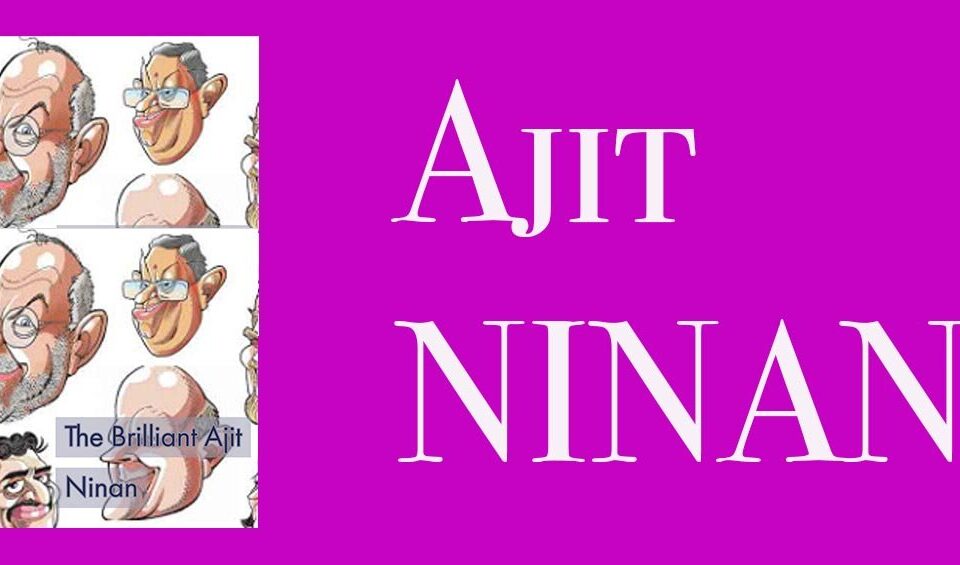The morning newspaper and a cuppa chai is a ritual that is common to a large part of the human race. But people read it in their own manner. Some glance at the headlines and head straight for the sports page. So open the editorial page and shake their head disapprovingly at the affairs of the world. I head for the cartoons. I grab the newspaper and head straight for Ajit Ninan's cartoon. I look for two elements of wit in a cartoon - the visual and verbal. Ninan excels in both. Usually one lands up choosing between the two. Ajit worked for many years with the India Today group as cartoonist and illustrator, before moving to the Indian Express newspaper in 1992 eventually switching to Outlook one of India's top news magazines. He is now with The Times of India as their Chief Graphics Consultant. Ajit used to run a cartoon strip called Detective Moochhwala (and his tail-less dog called Poochh, which means tail in Hindi) for the childrens magazine Target. That comic strip had cult status amongst readers and it was amazing to see Ajit pack in a tight storyline and brilliant graphics in about 35-40 frames.
It is hard not to get energized by supercop, mother, social worker and TV anchor Kiran Bedi (born 9 June, 1949). She is a bundle of energy and is always in a hurry. Her diminutive frame is deceptive. She is a woman of conviction and resilience to do what she has set out to. She has always attracted admirers and critics in equal measure.
To be able to write and to have access to forums that will publish one’s writing widely is a privilege. As a journalist and a reader I’m left in no doubt that there will always be people to write about the rich, the powerful, the glamorous; sometimes when they have nothing to say. But writing about such people, doesn’t impact them in the way writing about the marginalised and the alienated does. To write about those who have no voice, or whose voice has been silenced, is to empower them. Writing about the farmers of Vidarbha, who have been committing suicide since the 1990s, at one time at a rate of one every 12 hours, for example, has had a tangible impact on the political attention and economic stimulus offered to their community and their families. Having another profile written about Shah Rukh Khan, however, makes no difference to him, and frankly to readers—what more is there to learn about him?
I suppose the pyschologists and pyschiatrists - called "shrinks" in popular parlance - have their own code of silence. Once they are certified to practice, they are not supposed to give away the secret tests and techniques about how they figure out of the person lying on the couch is normal or abnormal depending on the response to the tests. To the person being tested this can evoke different feelings eg Awe or Aw (short for awful) and everything in between. So naturally people are anxious - which by itself could tell the shrink stuff about you that you don't want them to know.
So the word of caution to employers and employees alike: Don't do anything that would make you squirm if it made the headlines of every newspaper and TV channel in the world and where the anchors or scribes are your sworn enemies. Till you know what is good for you stick to Tweet Nothings.
How many books does an author have to sell before it is classified as bestseller in India? Why are Indian authors suddenly in demand? Have readers started noticing them because there is a proliferation of these authors in the bookshops in India? I believe there are many factors that have tapped into the collective potential of Indian authors - especially those who write in English. The foremost is the willingness of international publishing houses to identify local talent. What has happened is that readers who snootily ignored books that were not literary have started reading what was labeled as "commercial fiction or masala fiction".As you read this article by Sandhya Iyer, notice the happy confluence of events that lead to Indian Writing In English (IWE) growing out of its elitist bearings in the last few years to appeal to a wider mass readership, offering a variety like never before, says Sandhya Iyer in this article.
Collective nouns are a fascinating quirk in the English language. As the Rinkworks site would put it in the ir fabulous collection of collective nouns, "One of the craziest oddities of the English language is that there are so many different collective nouns that all mean "group" but which are specific to what particular thing there is a group of: a herd of elephants, a crowd of people, a box of crayons, a pad of paper, etc. There is great diversity of collective nouns associated with animals, from a sleuth of bears to a murder of crows."
There is a quaint little bookstore in Gurgaon, India called Quills and Canvas run by Shobha Sengupta and her husband Vivek. It is what you would expect your own cosy attic to be. Cramped but cosy, full of books of all genres, paintings by contemporary artists all existing cheek by jowl. I remember going there for a panel discussion with Sankarshan Thakur of Tehelka (http://www.tehelka.com/) the magazine that is credited with some sensational exposes, Paranjoy Guha Thakurta (media person and economist) and Amit Baruah is the Foreign Editor of Hindustan Times.
A Sachet (pronounced Sa-Shay) was a small packet of perfumed powder placed in drawers to make clothes smell nice. It also refers to "a small sealed usually plastic envelope containing a small portion of a substance such as shampoo" says the Collins dictionary. In India the term has become synonymous with shampoos. These sachets contain upto 10-20ml of shampoo that can be a convenient and affordable option for people even at the Bottom of the Pyramid (BOP). The cola giants had Rs5 bottles of Coke and Pepsi primarily targeted at this range. Other consumer good companies - think FritoLay's packs of potato chips - have launched products in the magical five rupee zone. From shampoo to colas to cell phones, the sachet marketing option is attractive to an increasing number of consumers. The British Economist EF Schumacher blasted away at the traditional thinking of bigger is better in his work "Small Is Beautiful: Economics As If People Mattered" as long back as 1973. His idea was that for developing economies mass production needs to be replaced with "production by the masses".CavinKare made its shampoo (brandname Chik) available in a one rupee sachet since 1989. Ten years later they tried to dig deeper into the rural market by introducing a 4ml shampoo sachet for half a rupee. On 14 Decmber 1983 when Maruti Suzuki invited the Prime Minister Indira Gandhi to launch the first ten 800cc cars, the middle class of India soon made it their darling. It was small (as compared to the tank like Ambassador or the box like Fiat and perhaps a Standard Gazelle) and sleek. The sachet version of a car.









